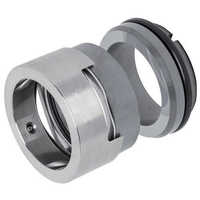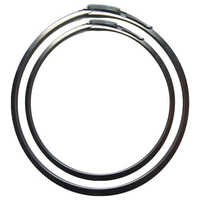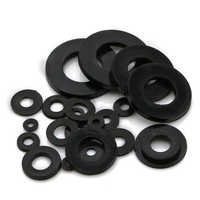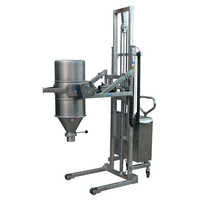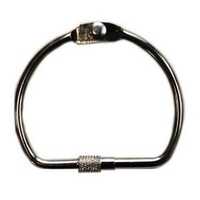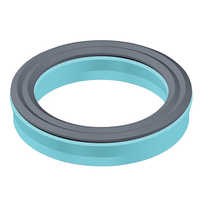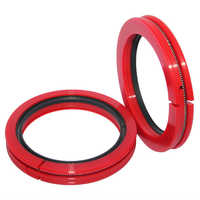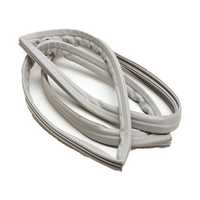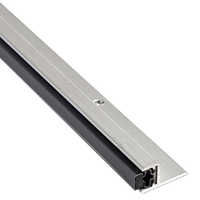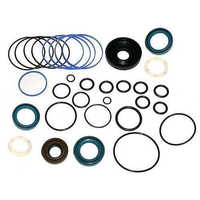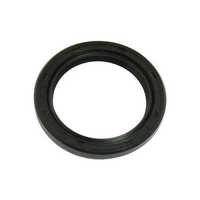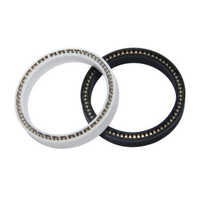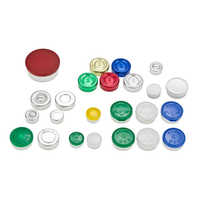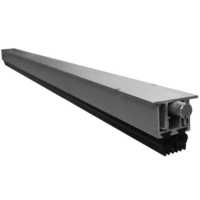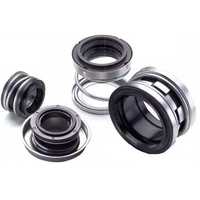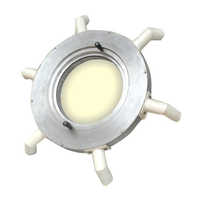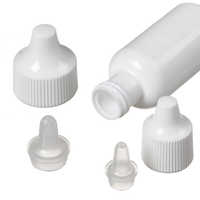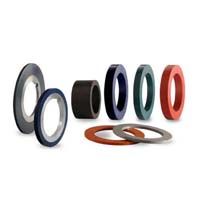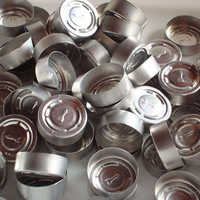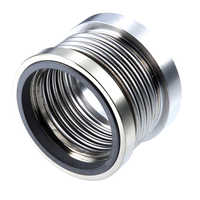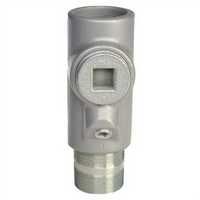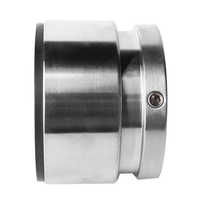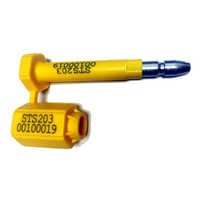Seals
(17004 products)
Explore More Categories
Economical Sponge Drum Seals
Price: 3 USD ($) (Approx.)/Piece
MOQ - 1000 Piece/Pieces
Medium - Water
Working Temperature - -10 to + 125 Celsius (oC)
Material - Rubber
8 Years
Business Type: Manufacturer | Exporter
SAGA ELASTOMER PVT. LTD.
Silver Headspace Crimp Aluminum Cap With Septa
Price: 800 INR (Approx.)/Pack
MOQ - 1 Pack/Packs
Product Type - HPLC Vials Crimper
Color - Silver
Material - Aluminium
3 Years
Business Type: Manufacturer | Distributor
CHROMATOGRAPHY WORLD
Ss Metal Bellows Seal
Price: 500 INR (Approx.)/Piece
MOQ - 10 Piece/Pieces
Material - SS
Style - Bellow Seal
Shape - Any
15 Years
Business Type: Manufacturer | Distributor
SHAH EXPANSION JOINTS (BELLOWS) MANUFACTURERS
Black Z Seal Dam Gate Seals
Price: 1450 INR (Approx.)/Meter
MOQ - 10 Meter
Thickness - 5-10 mm Millimeter (mm)
Color - Black
Product Type - Z Seal Dam Gate Seals
15 Years
Business Type: Manufacturer | Supplier
POLYERUBB INDUSTRIES
Indian Inquiries Only
Black Dowty Seals
Price: 8.00 INR (Approx.)/Piece
MOQ - 500 Piece/Pieces
Size - Different Sizes Available
Product Type - Dowty Seals
Color - Black
18 Years
Business Type: Manufacturer | Supplier
SOFTEX INDUSTRIAL PRODUCTS PVT. LTD.
Indian Inquiries Only
Guide Strips
Price Trend: 300-500 INR (Approx.)/Set
MOQ - 6 Set/Sets
14 Years
Business Type: Manufacturer | Distributor
SHENDE SALES CORPORATION
Phosphate Strap Buckle Size: Customize
Price Trend: 2000.00 - 3500.00 INR (Approx.)/Box
MOQ - 5 Box/Boxes
Material - Other
Size - Customize
3 Years
Business Type: Manufacturer | Distributor
Nilkanthvarni International Pvt. Ltd.
White And Black Gland Packing
Price: 7990 INR (Approx.)/Piece
MOQ - 1 Piece/Pieces
Usage - Industrial and Marine Pumps and Valves
Color - White and Black
Product Type - Zero Leak Gland Packing
19 Years
Business Type: Manufacturer | Distributor
JAY AGENCIEZ
Plain and Printed Drum Cap Seals
Price: 2.75 INR (Approx.)/Piece
MOQ - 50000 Piece/Pieces
Product Type - Capseal
Material - Metal
6 Years
Business Type: Manufacturer | Exporter
CONTINENTAL CROWNS & CLOSURES
White Non-Asbestos Gland Packing
MOQ - 1 Unit/Units
Product Type - Other
Color - White
3 Years
Business Type: Manufacturer | Distributor
WELD ARC ENGINEERS
Industrial PTFE Seals
Price: 1000 INR (Approx.)/Kilograms
MOQ - 1000 Kilograms/Kilograms
18 Years
Business Type: Manufacturer | Exporter
SANGHVI TECHNO PRODUCTS
Indian Inquiries Only
Security Seal Application: Industrial
Price: 50 INR (Approx.)/Piece
MOQ - 10000 Piece/Pieces
Color - Golden
Weight - 6.5 Kilograms (kg)
Product Type - Security Seal (TS-70)
16 Years
Response Rate: 90%
Business Type: Manufacturer | Supplier
TETRA TEKSEAL PVT. LTD.
Seals Manufacturers | Suppliers in India
| Company Name | Location | Member Since |
|---|---|---|
| Jay Agenciez | Surat, India | 19 Years |
| Softex Industrial Products Pvt. Ltd. | Kolkata, India | 18 Years |
| Sanghvi Techno Products | Ahmedabad, India | 18 Years |
| Shashi Fluoroplastiks | Vasai, India | 17 Years |
| Tetra Tekseal Pvt. Ltd. | New Delhi, India | 16 Years |
| Shah Expansion Joints (Bellows) Manufacturers | Vadodara, India | 15 Years |
| Polyerubb Industries | Ahmedabad, India | 15 Years |
| Surya Products Ltd. | Delhi, India | 15 Years |
| Hri Engineering Company | Gurugram, India | 15 Years |
| Mnm Composites Pvt. Ltd. | Mumbai, India | 14 Years |
Types of Seals
Introduction
The mechanical seals in centrifugal pump systems are essential. These components keep fluids inside the pumps and unwanted debris out, ensuring the longevity of the pumping systems.
For example, a notary seal is a tool used by a notary to authenticate legal and technical papers, while a security seal is intended to prevent things from being opened without authorisation or detect and notify the existence of tampering.
Users and operators must take responsibility for the upkeep of the mechanical seals. For this reason, it's crucial to learn everything you can about mechanical seals, from how they work to the conditions necessary for installation to common causes of their failure.
Here, a failures evaluation method on mechanical seal losses in the complex is consolidated in an effort to assemble the numerous failures that are seen with mechanical seals.
Seal Types
1. Axial Shaft Seal
Like radial shaft seals, axial shaft seals (or face seals) are used to stop process fluids from leaking along rotating shafts and elements and to keep contaminants out of the system. These seals are installed on the shaft and rotate with it; they consist of a stationary and rotating component, a spring-loaded seal, and a secondary seal (e.g., an O-ring) and are able to withstand slight variations in placement and shaft movement.
2. Radial Shaft Seals
Lip seals, or radial shaft seals, are used to seal the bearing elements of rotating shafts and other parts and to prevent pollutants from entering the equipment or system. These stationary seals prevent leakage around the periphery of the spinning component, and they typically have a metal inserts and an elastomeric membrane with a spring-loaded closing lip.
3. Labyrinth Seals
Labyrinth seals have an inner and an outer ring with a grooved route in between to prevent process fluids from leaking out or getting in. These seals prevent leaks from moving parts without making physical contact with them.
4. Cartridge Seals
Cartridge seals are mechanical sealing systems that include a shaft sleeve, seal, and gland plates, all of which are preassembled and ready to use. These units come in single, double, and tandem formats, each of which allows for speedy installation and removal.
5. Bellow Seals
For reciprocating machinery, bellow seals serve as both a primary dynamic seal and a spring. These gadgets can be constructed from metal, plastic, or elastomeric bellows, and they provide a secondary static seal.
6. O-Rings
O-rings, or packing, are a type of circular, ring-shaped mechanical gasket that has both static and dynamic uses. When compressed, an O-ring forms a leak-proof seal that can endure high temperatures and pressures and is designed to fit into a groove or housing between two parts.
7. Gaskets
Gaskets are used to seal joints and prevent leakage; they are often made of flat, elastomeric or similarly flexible material. Secondary seals in static applications can be found in a variety of device types and sizes.
8. Balanced mechanical seal
The term "balanced mechanical seal arrangement" is used to describe a system where the forces applied on the seal faces are equal. Lower face loading allows for more uniform lubrication of the seal faces, which in turn increases seal life.
9. Tandem Seal
This seal is not meant to provide a controlled environment like a double seal would, but rather to act as a backup in case the inner seal fails.
A closed reservoir is used to lubricate the outer seal by flooding the cavity between the inner and outer seals. The substance acts as a lubricant for the inner seal.
10. Pusher Seals
One or more springs are used in pusher seals to maintain the seal closing forces. Mechanical seals may use springs in either the revolving or stationary parts. Pusher type seals have the advantage of being able to provide fixing at extraordinarily high pressures, but they have a drawback in that the elastomer under the crucial seal face might be subjected to wear as the face advances and along shaft/sleeve during operation.
11. Water pump Seals
Due to water's lack of lubricity, it is crucial that water pump seals for applications such as spas, swimming pools, irrigation, heating systems, and shower pumps be made from durable materials.
12. Diaphragm Seals
Diaphragm seals, which often feature parallel springs, find widespread use in a variety of rotating shaft machines.
13. Air Seals
Air seals were developed to prevent leaks in spinning shafts without requiring any physical touch. Dry powder and slurry uses are typical settings for these seals. Minimal volumes of air or inert gas are used for protection against product loss, leaks, and contamination. The positive pressure and reliable seal are created by restricting this air.
What are seals used for in engineering
To prevent leakage between the hydraulic cylinders moving parts, engineers install engineering Seals at the cylinder's interfaces.
The seals are used in dynamic applications, typically with rotating or reciprocating motions and at high speeds.
For fluid sealing, they are used in hydraulic cylinders. They are located within the cylinder head, sealing against the cylinder bore to prevent fluid from bypassing the head. As a result, the cylinder can be expanded or contracted by increasing the pressure on one side of the piston.
When pressures are changing rapidly, the seal is put to use.
Washers used to seal fasteners are made of multiple components, including a metal backing and a vulcanized elastomer lip. Assuring constant, perfect compression conditions between the housing components to prevent the deterioration of the sealing lip, they perform a static function on flanges or threaded connections.
When using integral seals, a machining groove in the mating sealing flanges is not necessary. The elastomer is either mechanically or chemically bonded to a frame edge that is distinct from the flange, ensuring the seal remains in place.
These Seals are installed on moving or oscillating sections of machinery to prevent foreign matter like dirt and water from getting inside.
What are seals.
Industrial seals are installed at component interfaces to prevent leakage, maintain pressure, and deflect contamination. A static or dynamic interface is a common place to install an industrial seal. The connection between an engine block and cylinder head, as well as the entry point for bolts and screws, are also examples of static interfaces.
Static seals are often created with adhesives and gaskets. Sealants and gaskets work together to create a static seal. The seal between the piston and cylinder is an example of a linear dynamic interface, while the seal between the bearing housing and the axle is an example of a rotary dynamic interface.
Usually, mechanical seals have two flat surfaces that are perpendicular to the shaft, but we'll get to air seals in a minute. One side of the housing for the seal is fixed.
What are the advantages of seals
1. Compatible with any liquids Substances such as acids, salts, and abrasive particles
2. Disappointingly crooked/non-concentric handle.
3. Take on extreme variations in pressure, temperature, and speed, as well as bidirectional shaft rotation.
4. There is no pressing concern about the shaft's condition. Dimensions, shape, hardness, and composition of the finish
5. The seals ensure that there will be no mishaps caused by liquids leaking unexpectedly. Additionally, they lessen the possibility of slips and falls. The seal lessens the prospect of poisonous chemicals leaking out of the pump. For this reason, mechanical seals improve operational security.
7. Shaft wear is not a result of normal operation
8. Reliability that lasts for a long time in operation
9. Positive sealing for use with perishable foods, toxic materials, and radioactive liquids
10. Pump failure is less likely to occur when there is less fluid loss in the machine. Therefore, you avoid spending money on upkeep and repairs. It helps to lower overhead expenses.
FAQs: Seals
Q. What are the different types of seals?
Ans. Here are the basic types of Seals:
1. O-Ring
2. Labyrinth Seals
3. Water pump Seals
4. Axial shaft Seals
5. Cartridge Seals
6. Radial Shaft Seals
7. Balanced Seals
8. Unbalanced Seals
9. Pusher or Non-Pusher Seals
10. Gaskets
11. Bellow Seals
Q. How to select a mechanical seal?
Ans. Here are some Considerations
1. Design Options for Seals
2. Specifications of Seals
3. Reliability & Emission considerations
4. Liquid Characteristics
5. Pressure
6. Temperature
7. Liquid
8. Manufacturing Details
Q. What are seals in industry?
Ans. In the Mechanical industry, mechanical seals are used in pumping systems, to contain pressure, and to keep out contaminants, among other applications. Sealants rely on adhesion to be successful, while gaskets use compression to seal.
In the Engineering Industry, to prevent leaks at the points of entry or release of a drive shaft, mechanical seals are installed. An engineer can use a wet seal and embossing seal to authenticate documents.
Q. What are the two main categories of seals?
Ans. Here are the two main categories of Seals
1. Pusher Seals
2. And Non Pusher Seals
Related Categories
Abrasives
Acoustic Products
Acrylic Sheets
Air Blowers
Air Compressors & Air Separation Plants
Air Cooler
Air Dryers
Air Receiver
Air Valves
Aluminum Castings
Anchors
Anti Vibration Mounts
Ball & Roller Bearings
Ball Valves
Ballast Making Machines
Bearing Parts & Components
Bearings
Bellows & Expansion Joints
Belt Pulleys
Boilers, Components & Spares
Bolts
Bright Bars
Bristles
Burners/Industrial Burners & Incinerators
Bushings & Bushing Parts
Butterfly Valves
CNC Machined Components
Cable Pulleys
Capital Goods
Carbon & Graphite Products
Castor Wheels
Centrifugal Pumps
Centrifuges
Ceramics
Chains & Chain Link Fence Fittings
Cleaning Equipment
Clips, Clamps
Coils
Combustion Equipment
Compression Springs
Compressors & Allied Equipment
Control Valves
Conveyor & Conveyor/Industrial Belts
Cooling Tower & Chilling Plants
Corrosion Protection Materials
Coupling
Cranes
Cryogenic Equipment
Cutting Tools, Broaches & Cutters
Departmental Shelving
Diaphragm Valves
Die Castings
Dies & Moulds
Dies,Jigs,Fixtures
Diesel Engine & Electric Locomotive Spares
Draught Fan
EOT Cranes
Electric Hoists
Electric Motors & Engines
Electroplating Chemicals & Equipment
Elevators, Lifts & Escalators
Energy Management System
Engine Valves
Engineering Goods & Equipment
Engineering Plastics
Engraving Equipment
Extruded Profiles
Fasteners
Fiberglass Products
Filter Cartridges & Media
Filter Cloth, Filter Industrial
Filters-Air, Gas, Liquid
Filtration & Sedimentation Units
Flat Metal Processing Equipment
Float Valves
Fork Lift Truck Parts
Fork Lift Trucks
Forklifts
Foundry Raw Material & Equipment
Furnace Manufacturers
Galvanized Fasteners
Gantry Cranes
Gaskets
Gate Valves
Gauges & Gauge Glasses
Gear Boxes, Reduction Gears & Gear Cutting
Girder Cranes
Glass & Glass Products
Glass Cutting Tools/Glass Cutters
Globe Valves
Goliath Cranes
Grating
Hand & Allied Tools
Hand Pump
Hardware & Tools
Heat Exchangers
Heating Elements
Hex Bolts
Hex Nuts
Hooks & Mounts
Hoses
Hot Air Oven
Humidification & Ventilation Equipment
Hydraulic Hoses & Flexible Metal
Hydraulic Press
Hydraulic Press Brakes
Hydraulic Products & Equipment
Hydraulic Valves
Induction Heating Equipment
Industrial Automation
Industrial Brakes
Industrial Brushes
Industrial Clothing
Industrial Clutches
Industrial Cylinders
Industrial Dryers
Industrial Evaporators
Industrial Knives
Industrial Nets
Industrial Ovens
Industrial Rollers
Industrial Supplies Stocks
Industrial Supplies-General
Industrial Tape
Industrial Tools
Industrial Valves
Industrial Vibrator
Inspection Equipment
Instrumentation
Internal Combustion Engine
Jib Cranes
Laboratory Furniture
Laboratory Glassware & Equipment
Laundry Equipment
Lined Valves
Machine Tools Accessories
Marking Systems
Material Handling Equipment
Measuring Tools & Equipment
Mechanical Seals
Metallised Capacitor Films
Mining Equipment
Mining, Exploration & Drilling Machinery
Model Making Materials
Motor Couplings
Moulded Components
Moulds
Needle Valves
Needles
Nuts
Oil Seals
Outdoor Cooling Systems
Overhead Cranes
PVC Hoses
PVC Products
Paint Brushes
Painting Equipments & Maintenance
Perforated Sheets
Plastic Processing Machinery Parts
Plastic Valves
Plastic Welding Equipment
Plate Valves
Plug Valves
Pneumatic Products & Tools
Pneumatic Valves
Polish & Polishing Material/Machinery
Power Press
Precision Brass Components
Pressed Components
Pressure Gauges
Pressure Vessels
Pulleys
Pulverizers
Pump Spares Parts
Pumps & Pumping Equipment
Radiators
Refrigeration & Equipment
Rope Pulleys
Rope,Twines & Webbings
Ropes
Rotary Valves
Rubber & Rubber Products
Rubber Gaskets
Rubber Roller
Rubber Seals
Rubber Transmission Belts
Screws
Seals
Sensors & Transducers
Shaft Couplings
Shafts & Shaft Collars
Sheet Metal Components & Parts
Solenoid Valves
Springs
Stainless Steel Bolts
Stainless Steel Fasteners
Stainless Steel Nuts
Stainless Steel Valves
Storage Systems
Storage Tanks
Submersible Pumps
Surface Finishing Equipment
Synthetic Industrial Diamonds
Testing & Measuring Equipment
Thermostatic Bimetals & Thermostats
Trolleys & Carts
Tungsten Carbide
Ultrasonic Equipment
V-Belts
Vacuum Equipment & System
Valves
Valves Fittings
Vibrating Screen
Washers
Water Coolers
Weighbridge
Welding & Soldering Supplies
Welding Electrodes
Welding Equipment
Winches
Wire Drawing Dies
Wire Rope Hoists
Wire Ropes
